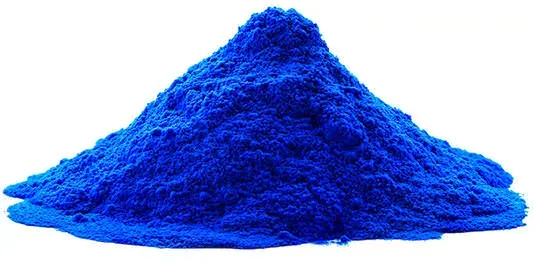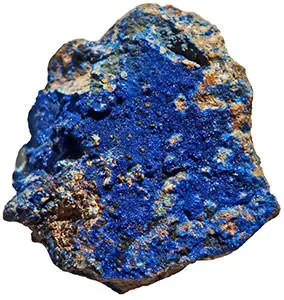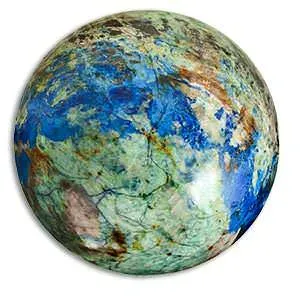 Azurite is a blue copper mineral created by weathering in the upper oxidation zone of copper ore. The name azurite is derived from the stone's azure blue color. Azurite is most typically used for ornamental objects. It was also widely used in the ancient world and throughout the middle ages as a pigment and dye as it was valued for its beautiful range of blue colors. It was most popular with painters in the middle ages. Today, azurite it is still used as a color base for some paints. However, its oxidation process is ongoing, and overtime its color may tend towards greenness when it is used in paints without fixatives. In ancient Egypt, azurite was associated with the studies and arts that improve mental disciplines. Ancient Egyptians used azurite for carving ornaments. Azurite was also one of the stones believed to have been used in the lost, mythical city of Atlantis.
Azurite is a blue copper mineral created by weathering in the upper oxidation zone of copper ore. The name azurite is derived from the stone's azure blue color. Azurite is most typically used for ornamental objects. It was also widely used in the ancient world and throughout the middle ages as a pigment and dye as it was valued for its beautiful range of blue colors. It was most popular with painters in the middle ages. Today, azurite it is still used as a color base for some paints. However, its oxidation process is ongoing, and overtime its color may tend towards greenness when it is used in paints without fixatives. In ancient Egypt, azurite was associated with the studies and arts that improve mental disciplines. Ancient Egyptians used azurite for carving ornaments. Azurite was also one of the stones believed to have been used in the lost, mythical city of Atlantis.
 Despite its attractive blue color, azurite is not used frequently in jewelry because of its low hardness, rating only a 3.5 to 4 on the hardness scale. However, one can still find simple, beautiful jewelry pieces made of azurite as it may be coated with wax or other clear substances to protect it. Azurite is formed either by water containing carbon dioxide reacting with copper bearing minerals, or by cupric salts reacting with limestone. It is occasionally found as prismatic crystals but is more often found in massive forms, and is often found intergrown with malachite, creating fabulous green and blue color effects. The mixture of azurite's deep blue and malachite's vivid green is a beautiful, colorful stone known as azurmalachite. Azurmalachite is very popular with jewelry enthusiasts and gem collectors.
Despite its attractive blue color, azurite is not used frequently in jewelry because of its low hardness, rating only a 3.5 to 4 on the hardness scale. However, one can still find simple, beautiful jewelry pieces made of azurite as it may be coated with wax or other clear substances to protect it. Azurite is formed either by water containing carbon dioxide reacting with copper bearing minerals, or by cupric salts reacting with limestone. It is occasionally found as prismatic crystals but is more often found in massive forms, and is often found intergrown with malachite, creating fabulous green and blue color effects. The mixture of azurite's deep blue and malachite's vivid green is a beautiful, colorful stone known as azurmalachite. Azurmalachite is very popular with jewelry enthusiasts and gem collectors.
 As its name implies, azurite is found in an array of colors like the sky, from a very light blue to the more common deep and royal blue shades. Copper gives azurite its distinctive blue color. Azurite is found particularly in copper mining areas such as Australia, Chile, the former USSR, Africa, and China. Other deposits of azurite are found in Tsumeb, Namibia, Adelaide, Australia, and in the United States in Utah, New Jersey, and Arizona. Stones from Chessy near Lyons in France, are called Chessylite. Never clean azurite with any product containing ammonia. In seconds, the ammonia will remove all the polish, which will significantly reduce the stone's beauty.
As its name implies, azurite is found in an array of colors like the sky, from a very light blue to the more common deep and royal blue shades. Copper gives azurite its distinctive blue color. Azurite is found particularly in copper mining areas such as Australia, Chile, the former USSR, Africa, and China. Other deposits of azurite are found in Tsumeb, Namibia, Adelaide, Australia, and in the United States in Utah, New Jersey, and Arizona. Stones from Chessy near Lyons in France, are called Chessylite. Never clean azurite with any product containing ammonia. In seconds, the ammonia will remove all the polish, which will significantly reduce the stone's beauty.
 Azurite can be used to help the body remain strong. It has been known to promote health and healing in the upper respiratory area, and oddly enough, it supposedly helps to decrease unhealthy tissue growth such as cysts and tumors. Mentally, azurite is beneficial for one's brain and mind, bringing clarity to situations, which might otherwise be confusing and difficult to understand. Azurite is also good for inspiration and it contains the virtue of spiritual balance. It helps those on spiritual paths find balance and helps them to pursue their deepest thoughts and dreams. Azurite is also good for mental growth and focus, and enhancing wisdom and maturity.
Azurite can be used to help the body remain strong. It has been known to promote health and healing in the upper respiratory area, and oddly enough, it supposedly helps to decrease unhealthy tissue growth such as cysts and tumors. Mentally, azurite is beneficial for one's brain and mind, bringing clarity to situations, which might otherwise be confusing and difficult to understand. Azurite is also good for inspiration and it contains the virtue of spiritual balance. It helps those on spiritual paths find balance and helps them to pursue their deepest thoughts and dreams. Azurite is also good for mental growth and focus, and enhancing wisdom and maturity.